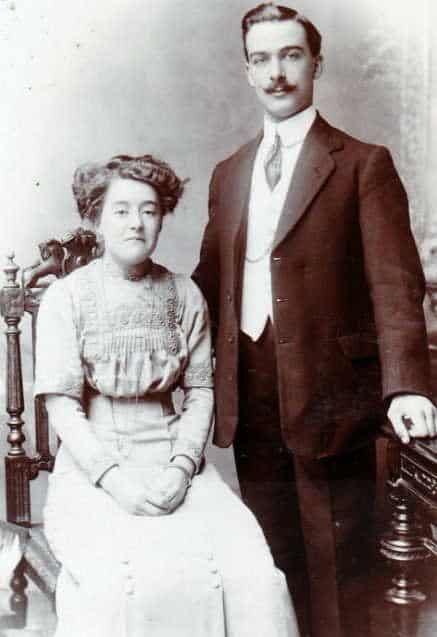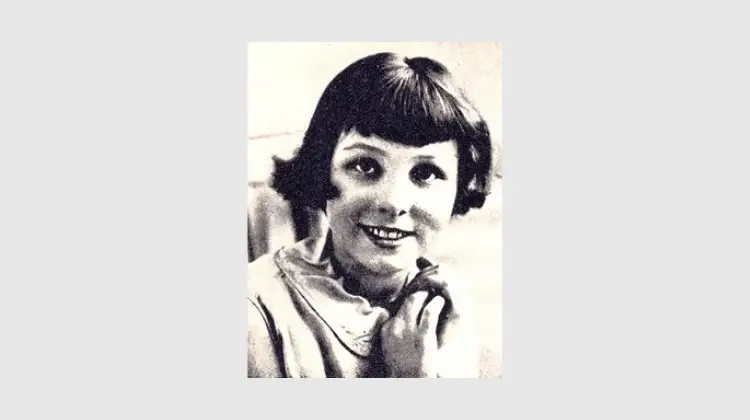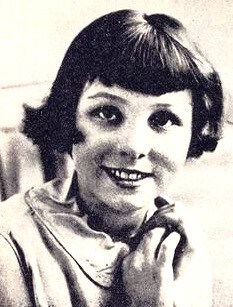10-year-old Vera Page of Notting Hill, London, England disappeared in December 1931. A man found her body two days later about a mile from her home. She had been raped and strangled. While there was a suspect in her murder, no one was ever charged.
The Page Family
Charles and Isabel (née Essex) Page were married in the summer of 1918. Less than three years later, their only child, Vera Isobel Minnie Page was born in Hammersmith, London. The family later moved to Chapel Road in Notting Hill (now known as St. Marks Place). Charles worked as a painter for Great Western Railway, and Isobel was a housewife.
Vera attended Lancaster Road School. She was a shy and well-behaved child who had many friends.
In January 1931, the working-class family moved to 22 Blenheim Crescent in Notting Hill. Isabel’s niece, Maud Essex, 23, and her boyfriend, Harry Lovatt, 24, resided with the family. Vera’s grandmother and her aunt Minnie lived nearby.
As was common in the day, the Page family did not occupy the entire house; They lived on the ground floor and boarders lived on the top.
Arthur Rush, 71, and his wife, Annie, 70, had resided on the top floor of the home for 20 years by the time the Page family moved in. The couple married in 1891 and their first-born child, Percy Orlando Rush, was born the same year. The couple had a total of four children. By 1920, Percy was still living with them. In 1921, he married Daisy Lillian Wheeley, and the two lived with Percy’s parents until 1925 when they moved into the top floor of a home nearby on Talbot Road. Percy visited his parents at least once a week after he and Daisy moved out.
The relationship between the Pages and Rushes is not known. However, each family was considered close knit.
The Disappearance of Vera Page
On the afternoon of December 14, 1931, Vera Page arrived home after school as usual. Soon after, she walked to her aunt Minnie’s home, about 200 yards away at 70 Blenheim Crescent to retrieve her two swimming certificates she left behind. Isabel reminded Vera to not be late because tea would be ready by 5:30 p.m.
Vera was wearing black shoes, stockings, a blue gymslip with black braid, a blue jacket coat, a red woolen jersey, and a red beret.
The young girl arrived at Minnie’s house around 4:30 p.m. She collected her certificates and put them into a large envelope. Vera left Minnie’s house at 4:45, but she did not go straight home as she originally planned.
Vera walked past her house and continued on to Portobello Road.
She was next seen around 5:00 p.m. by two school friends, Charles Hewett, 12, and Irene Stegman, 13, looking into Taylor’s, a chemist shop at the junction of Portobello Road and Blenheim Crescent. It was Christmastime and Taylor’s had a window display of soap that resembled dominoes. Vera wanted to purchase them as a gift for her parents. An unknown man and woman were also standing in front of Taylor’s.
Around 6:30 p.m., John Barden, a ship’s steward, saw Vera gazing into another shop window. No sightings of Vera occurred between 5:00 p.m. and 6:30 p.m. Therefore, her whereabouts are unknown during this time.
At 6:45 p.m., salesman Robert Ritches saw her on Montpelier Road (now Lansdowne Rise), walking in the direction of Lansdowne Crescent. He knew Vera because he used to live with the Page family prior to their move to Blenheim Crescent. Ritches said she was wearing a red beret and carrying a large envelope. However, police called him an unreliable witness and considered him ‘a shifty individual’ who had been convicted eight years prior for embezzlement. Police thought he may not have seen her.
There were no other sightings of Vera Page.
When Vera had not arrived home by 5:30 p.m., Charles and Isobel began searching for her, visiting relatives and friends of the girl. When Vera still was not home by 10:25 p.m., Charles and Isobel went to the police station to report their daughter as missing.
A Tragic Discovery
Around 9:00 p.m. on December 15, 1931, the day after Vera disappeared, Kathleen Short, who lived nearby on Stanley Crescent, found a red beret and scraps of paper outside her property. She took the red beret into her home and put it aside. Then, she swept up the scraps of paper and threw them away. These were most likely the remains of Vera’s swimming certificates because those were never found.
The next morning around 6:40 a.m., Margaret Key was walking to work from her home on Goldhawk Road, Shepherd’s Bush. Key was walking along Holland Avenue. At the junction with Holland Park Gardens, she saw a man crossing the main road, from Addison Avenue, and walking southwards. He was wheeling a coster‘s barrow, in which a large bundle was covered by a red cloth with a knitted fringe (Oates, 2009, p. 120).
This was not an unusual sight in Notting Hill at the time; Men were often seen wheeling barrows around.
Later that morning at 9:50, a milkman named Joseph Smith was delivering milk near Holland Park when he found the body of Vera Page in the front garden of a home on Addison Road. The home was owned by the widow of a man named Charles Smith. Dirt and leaves partially concealed the body.
“The moment I stepped into the garden, I saw the body. The child was lying on her right side, and the lapel of her coat almost covered her face … she looked as if she was lying asleep under the bushes, except that her face was like marble. I told the cook at the house, and then went out and found a policeman [PC Wager].” (Oates, p. 120)
Joseph Smith had been at the home earlier that morning around 5:30 a.m delivering milk to Mrs. Smith. The body was not there at that time. Moreover, Mrs. Smith left home the night before at 10:20 p.m. and again the morning of the 16th around 7:50 a.m. and saw nothing out of the ordinary.
Superintendent George Cornish and Detective Inspector Mallett arrived on scene shortly after Joseph Smith contacted PC Wager. The two inspected the body. Vera was fully-clothed but not wearing her red beret. Candle grease spots were found on her clothes and traces of coal dust was on her face. In the crook of her right elbow was a fingerstall, which was of lint and smelled of ammonia.
After searching the grounds, police did not find any more evidence. They theorized the body could not have been there the night before because it had rained, and the body was dry. Given the coal dust found on her clothes, police figured the body was kept in a coal cellar prior to its discovery.
Autopsy
Dr. William Kirkwood, the divisional surgeon, arrived on scene at 10:20 a.m., and Sir Bernard Spilsbury, a Home Office pathologist, carried out a post mortem at 4:30 p.m. Vera Page was sexually assaulted prior to death, and cause of death was manual strangulation. Markings of a cord were found on the neck. Time of death could not be determined but Spilsbury believed it to be the night she disappeared.
Spilsbury noticed that the body was still warm and decomposition was relatively advanced leading him to believe the body had been kept in a warm place until the killer disposed of it on Addison Road.
There is no surviving record of the examination of stomach contents, so Vera’s last meal is not known.
Investigation
A short time after Vera’s body was found, Kathleen Short found a candle near a disused coal cellar in the area of a house where Vera had disappeared. She took this and the red beret to the police who identified it as belonging to Vera Page. Detectives found paraffin on the beret.
Police then contacted Vera’s parents to tell them they found their daughter. Heartbroken, Charles Page spoke of Vera and said, “She was our only little girl, a fine little lass, and I could not imagine anyone wanting to do her harm. she was full of fun and life, and was the joy of our hearts.”
About 200 detectives were assigned to the investigation led by Superintendent Cornish. Over 1,000 statements were taken and and police searched sheds, garages, and unoccupied apartments. Detectives showed Vera’s photograph to people hoping to jog their memory. They questioned several men known to have “indecent tendancies”. At least three of these men were questioned at Ladbroke Road Police Station in Holland Park. One of them was Percy Rush.
Detective Inspector Mallett interviewed Rush again at Notting Hill Police Station on December 18, 1931.
About Percy Rush

Daisy and Percy Rush. Photo credit: GreatWarForum.org.
During the Great War, Percy volunteered for military service and was a private in the King’s Royal Rifle Corps from 1914-1920. In 1923 and 1927, he was convicted of indecent exposure and recieved a one-month prison sentence for each offense.
In 1929, he was out of the military and started working as a flannel washer for Whiteley’s Laundry. Between 1929 and 1931, a man fitting his description exposed himself to two women – Rose Napper and Queenie Marshall – at Rosemead Road. Percy was picked out in a lineup and charged at West London Magistrate’s court in January 1932 where he pleaded not guilty. He was discharged shrotly after.
In June 1931, Percy exposed himself to two school-age children. A local newspaper described him as “behaving indecently with intent to insult females”.
First and Only Suspect
Because of his history, police searched his home and tested his clothes in a laboratory. Semen and coal dust was found on the clothes. Parrafin was found in his apartment, and he and Daisy had a coal cellar. However, thousands of residents had coal cellars, so this was not out of the ordinary.
But one of the most interesting clues found was on Percy’s finger – he had two small sores there. He said he injured himself at work about two weeks prior to Vera’s murder. Ammonia, which was found on the fingerstall next to Vera’s body, was commonly used in laundries and was used at Whiteley’s where Percy worked.
Percy admitted to having a bandage soaked in ammonia wrapped around his finger but insisted he threw it in a fire on Friday, December 11, 1931 so the fresh air would help heal the wound. He also claimed he was not wearing any bandage at all on the day Vera disappeared.
The bandage found with Vera’s body fitted perfectly on Percy’s finger.
Dr. Roche Lynch examined the bandage found with Vera and wrote in a report, ‘After the examination of photographs, examination by ultra violet light and other tests I have come to the conclusion that the lint and the bandage forming the finger bandage are different from the samples found at Rush’s house.’ (Oates, p. 126)
Percy admitted to police that he knew Vera Page.
According to Percy:
I knew Vera Page. She was a pretty sweet little kid. I liked her. I always looked upon her as a nice little girl. I have never given her sweets, money or toys. I have seen her playing in the streets outside her own home, I last saw her about three weeks ago.
Later, Percy changed his story and said he had seen her but had only said good evening to her. He also claimed he would not have recognized her in the street.
Percy told police that on Monday, December 14th, he left for work at 8:30 a.m. He took a lunch break between 1:00 and 2:00 and left work for the day at 5:55 p.m. Daisy was visiting her mother, so Percy took his time getting home. Normally, he would have taken a bus to Notting Hill Gate and then walked home. Instead, he stopped by a local Woolworth’s to purchase collar studs. He left the store at 7:00 p.m. and decided to walk a longer route home, arriving much later than normal at 8:15. He and Daisy went to bed at 10:45 p.m.
Percy also said he did not visit his parents that day or the next day, even though he always visited them on Monday or Tuesday. He claimed that after work on Tuesday night, he took his normal route home and got there around 7:15. He did not go anywhere the rest of the night.
Police never verified his account.
Location of Murder
Because Vera had coal dust on her face when she was found, police thought that she was either killed in a coal cellar or placed in one after death. The coroner believed that she was placed in a warm place after death, such as an inhabited room, because her body was warm when it was found. So, that left them with the possibility of the murder taking place in a coal cellar.
Kathleen Short, who found the beret and candle, and her family had a coal cellar. On the night of the murder, the cellar door was unlocked. Thomas McDougall O’Conner, a tenant of Kathleen’s, left on December 9th and took the padlock with him, making the cellar accessible to anyone.
The Short family had a gramophone on which they played records every evening. They would turn the gramophone up full blast. If the rape and murder took place in their cellar while the music was playing, they would not have heard Vera’s screams.
The Funeral of Vera Page
Vera Isobel Minnie Page was laid to rest on December 23, 1931. Her funeral took place at Presbyterian Mission Hall where she attended Sunday School. Reverend Guthrie, who officiated the service, said, “There is nothing I can say to you who mourn in bitter sorrow, except that your grief is being borne today by the whole nation.” Vera was buried in Kensington Cemetery in Gunnersbury Park, which had just opened prior to her death. Four days after her burial, many people visited her grave. Police were also there thinking the killer might make an appearance.

The grave of Vera Page. Photo credit: Connie Nisinger @ Find a Grave
Coroner’s Inquest, Theories, and Witnesses
A coroner’s inquest was opened on December 18, 1931 by Westminster coroner, Samuel Ingleby Oddie at Paddington Police Station, but it was adjourned. However, Oddie was enthusiastic to bring it to a successful conclusion, later writing of his ‘fixed determination to spare no effort which might lead to the discovery and apprehension of this terrible monster.’ (Oates p. 130)
There were a couple of theories floating around by the local press. One suggested that a small, dark man wearing a black overcoat and a bowler hat abducted and killed Vera. He was seen attempting to lure children into his car with sweets and money.
Another was an alleged sighting of Vera riding on the handlebars of a bicycle ridden by a well-dressed man, with a black mustache and scar on his face.
Because stranger abductions were considered rare, police discounted these theories.
Two women who lived in a flat in Ladbrooke Grove, opposite Stanley Gardens, said at about 8:30 p.m. on December 14, 1931, they heard a scream, “It was the scream of a child in pain’. They could not, however, see anyone from across the road. As one declared, ‘There was not a soul in sight. It was most eerie. This sudden single shrill cry coming through the night’. (Oates, p. 133)
There were a few other witness statements but police did not believe these were in connection with the murder.
In February 1932, the adjourned coroner inquest resumed. Rush was questioned and denied seeing Vera on December 14th, the day of her disappearance, and no one reported seeing Vera in the company of Rush on that day. Police interviewed local chemists but none of them recalled selling the type of bandages discovered with Vera’s body to Percy Rush. Additionally, Rush did not own a coster’s barrow nor could police find any evidence that someone had sold him one or that Rush borrowed a coster’s barrow from someone else.
The jury did not hear about Percy Rush’s indecent exposure charges in 1923 and 1927 or the semen found on his coat. However, they did know about his loitering at night.
After five minutes of deliberation, the jury reached an open verdict of murder by person or persons unknown, and Percy Rush was never charged in Vera’s murder.
Aftermath
The investigation into the murder officially ended in 1932, but the case remained open for decades. Police were never convinced of Rush’s guilt, but no one else was ever charged with Vera’s murder.
During the entire investigation into Vera Page’s murder, Daisy Rush, Percy’s wife was never named in the proceedings nor was she ever questioned by police in regards to her husband’s activities. While she was never considered a suspect, police did believe it possible that someone was shielding the killer and that a woman might have lured Vera away instead of a man. A child would have been more likely to trust a woman versus a man.
Charles and Isabel Rush were never considered suspects in their daughter’s murder either, and police never seemed to have given that a thought. The couple moved out of their Blenheim Crescent home in 1932. Charles died in 1959 at the age of 67 and was buried with Vera. It is not known when Isabel died.
Daisy Rush died in 1937 at the age of 46. Percy Rush lived in their home on Talbot Road until 1947. He never committed any more crimes and passed away from natural causes in 1961 in the Ealing district of west London.
True Crime Diva’s Thoughts
I’m keeping this part short because the main article is long.
It makes the most sense that Percy Rush killed Vera. He knew her and lived nearby on Talbot Road. Additionally, he visited his parents who lived on the top floor of Vera’s home, at least once a week, and did so on Mondays and Tuesdays. He had the injury to his finger and the bandage found with Vera’s body was a perfect fit on his finger.
But you also have to wonder about the men who saw her at 6:30 p.m. and 6:45 p.m. respectively – John Barden and Robert Ritches. The latter was the very last person to see Vera, and he knew her as well. The location where he claimed he saw her – Montpelier Road – is only a 5-mile walk to Stanley Crescent where her beret was found. Additionally, her body was found on Addison Road which is less than a mile from Stanley Crescent. He put himself in the area when he claimed he saw her. Did he have any injuries on his fingers?
I think it was stupid on the part of police to think he had not seen her. He knew she was wearing a beret and carrying a large envelope. I think he is just as likely to be her murderer as Percy Rush was.
Why didn’t the killer completely dispose of Vera’s beret? Why did he toss it, and possibly her certificates, on Stanley Crescent for someone to find? He could have burned them somewhere. For that matter, why did he leave Vera’s body in plain sight? Usually when a killer does not attempt to really conceal the body, it often means he wants the victim found.
Sources:
Ashby, J. (2019). The insider’s guide to London’s Notting Hill. Retrieved from https://www.lonelyplanet.com/england/london/notting-hill-and-west-london/travel-tips-and-articles/the-insiders-guide-to-londons-notting-hill/40625c8c-8a11-5710-a052-1479d2778bc9
Nisinger, C. (2019). [Image]. Retrieved from https://www.findagrave.com/memorial/5903442/vera-page
Oates, J. (2009). Unsolved London Murders: The 1920s & 1930s. Barnsley: Wharncliffe.




